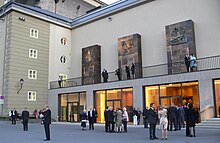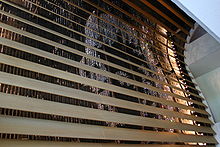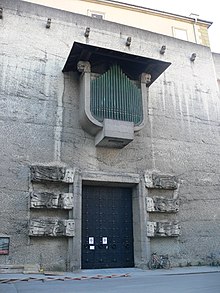House for Mozart
The House for Mozart is one of the venues for the Salzburg Festival in Salzburg's old town . The first festival hall was located here from 1925 , and this venue has been called the Haus für Mozart since 2006 (from 1925 to 1959 it was called the festival hall , from 1960 to 1962 the old festival hall , from 1963 to 2004 the small festival hall ). Mainly operas and concerts are held here.
First projects
First plans for the construction of a festival hall on the Mönchsberg in Salzburg by the Viennese architects Hermann Helmer and Ferdinand Fellner the Elder. J. did not get beyond the planning stage.
The Berlin architect Hans Poelzig created the plans for a festival hall in the park of Hellbrunn Palace . However, the project did not progress beyond the laying of the foundation stone: Richard Strauss performed the symbolic three hammer blows, but no more stone was to follow.
Eduard Hütter
The conversion of the former court stables into a mystery stage under the direction of the Salzburg state curator Eduard Hütter created the first Salzburg Festival Theater, which was opened in 1925 with Hugo von Hofmannsthal's Das Salzburger Großes Welttheater under the direction of Max Reinhardt (this work was premiered in In 1922 in the Kollegienkirche ).
Clemens Holzmeister
Immediately after the first season, the festival hall was rebuilt for the first time under the direction of Clemens Holzmeister and was available as alternative accommodation for everyone . The first performance in the converted Festspielhaus was Carlo Gozzi's play Turandot, arranged and translated by Karl Gustav Vollmoeller and directed by Max Reinhardt in the summer of 1926.
The first opera performance was Fidelio by Ludwig van Beethoven under the direction of Franz Schalk , for which Clemens Holzmeister designed the sets.
In 1936, the next renovation followed again under Clemens Holzmeister and intensive advice from the conductor Arturo Toscanini , who also directed the first opera performance, again Fidelio .
Benno von Arent
After Austria was annexed to the German Reich in 1938, the frescoes by Anton Faistauer , the mosaics by Anton Kolig and the sculptures by Jakob Adlhart were considered degenerate art , Clemens Holzmeister was no longer politically opportune, and so the next renovation followed under the direction of the “Reich set designer “ Benno von Arent . The first performance was Der Rosenkavalier by Richard Strauss under the direction of Karl Böhm in 1939.
Hans Hofmann and Erich Engels
After the end of the Second World War, a further renovation was initially out of the question.First, the New Festspielhaus (today: Großes Festspielhaus , architect Clemens Holzmeister, opened in 1960) was built, then what is now the Old Festival House was built by Salzburg architects Hans Hofmann and Erich Engels rebuilt and reopened in 1963 with Mozart's Le nozze di Figaro under Lorin Maazel .
From now on this stage was called the Kleines Festspielhaus , this was not very popular, and so there were plans for a new renovation early on. After Clemens Holzmeister had redesigned the auditorium of the Felsenreitschule in 1970 , he presented corresponding plans in 1978, which he later revised to enable simultaneous use of the Felsenreitschule and the Small Festival Hall - but these plans were made despite the advocacy of Herbert von Karajans never executed.
Wilhelm Holzbauer and François Valentiny
For the Mozart year 2006, the former court stables were rebuilt for the last time, which is now the sixth time. The architects were Wilhelm Holzbauer , a student of Clemens Holzmeister, and the Luxembourgish François Valentiny , since then the house has been called the House for Mozart . The artist Josef Zenzmaier was responsible for the design of the three entrance portals , while the German artist Michael Hammers was entrusted with the design and manufacture of the golden wall in the foyer . Le Nozze di Figaro was performed again at the opening ceremony , this time under the direction of Nikolaus Harnoncourt .
The Haus für Mozart now has space for 1,580 people, with 1,495 seats and 85 standing places.
External organ
A special feature of the Haus für Mozart is an outside organ with an organ prospect facing the Toscaninihof. In 1925 the House of Music received a large organ, which was expanded to 58 registers when the house was rebuilt. The third manual was converted into an external organ by Max Dreher in 1938. From 1962 the instrument was decommissioned and more or less forgotten until it was formally rediscovered in 2009 and has been heard again since a restoration and partial reconstruction by the organ builder Wolfgang Bodem. The cone store instrument has 18 stops on a manual and pedal. The playing and stop actions are electric.
|
|
|
|||||||||||||||||||||||||||||||||||||||||||||||||||||||||||||||||
Trivia
The facade of the house was used as the noble Hotel Nouveau Rothschild in the US action film Knight and Day with Cameron Diaz and Tom Cruise .
See also
Web links
Individual evidence
- ↑ Andrea Gottdang: Program and Propaganda. Hans Poelzig's preliminary project for the Salzburg Festival Hall . In: INSITU. Zeitschrift für Architekturgeschichte 2 (2/2009), pp. 223–240.
- ↑ newroom: Kleines Festspielhaus - competition . In: nextroom.at, April 4, 2003
- ↑ Information on the organ
- ↑ Six days of Hollywood: Star hype in Salzburg In: derstandard.at, November 19, 2009, accessed on July 24, 2013.
Coordinates: 47 ° 47 ′ 52 " N , 13 ° 2 ′ 33" E





